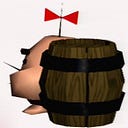Courting the Player in Super Mario 64
Support my writing on Patreon or Ko-fi!
Written for Critical Distance’s First Foot Forward February writing jam.
Princess Peach’s Castle is an anchor without a ship. It has appeared in myriad Mario games since Super Mario 64, yet its architecture and exterior grounds always appear slightly different. Even the one constant, a stained glass portrait of Peach herself, was originally a compass rose in an early version of the game. Thus Peach’s Castle has always been and remains a fixed orientating point in the ever-shifting landscape that is the Mushroom Kingdom. More so than Bob-omb Battlefield the castle grounds are SM64’s true first level, the first time we see Mario in his in-game form and the first place we as players gain control of him.
Whether most players are aware or not these first moments of the game present a series of choices–choices which the game’s designers were well aware of. “That was our big gamble” says game director Shigeru Miyamoto in a 1996 interview for a Japanese strategy guide, “We thought that half the people would just go straight into the castle, and half would hang out and explore outside[…]We made the game with that latter half of players in mind. I’m not saying that either way is ‘correct’, of course.” Perhaps because it mirrors my own childhood experience, I like the idea that the game as a walkthrough would have you understand it is oddly secondary to this more aimless form of play. It’s telling for example that one of the first things the player can do in Mario 64 is climb trees.
But even if the player does choose to enter the castle, the way they do so is still indicative of Super Mario 64’s design ethos. During the camera fly-through of the intro cutscene Lakitu follows a clearly demarcated path which leads to the clearing where Mario emerges from a warp pipe. However, the most direct path to the castle entrance is to cut through the grass up a small incline. Here the game wordlessly imparts upon the player that the various challenges in store can be approached from different equally valid angles.
